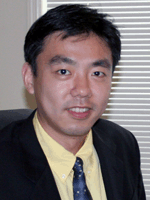Home > Press > New Material Could Efficiently Power Tiny Generators
 |
| Xudong Wang |
Abstract:
To power a very small device like a pacemaker or a transistor, you need an even smaller generator. The components that operate the generator are smaller yet, and the efficiency of those foundational components is critical to the performance of the overall device.
New Material Could Efficiently Power Tiny Generators
Madison, WI | Posted on October 22nd, 2009For his Ph.D. at the Georgia Institute of Technology, University of Wisconsin-Madison materials science and engineering assistant professor Xudong Wang was part of a team that developed a piezoelectric nanogenerator and experimented with a variety of materials to power it.
The team found that zinc oxide nanowires, which have six-sided, column-like crystals, could produce 10 nanowatts per square centimeter by converting mechanical energy into electricity. The mechanical energy could come from environmental sources as varied as wind, car engines, human breathing, blood flow, body movements, or acoustic and ultrasonic vibrations.
While the advance was exciting, the zinc oxide nanowires had a low efficiency rate, and now at UW-Madison, Wang is tackling this challenge by researching a new material that could make the nanogenerator more efficient and powerful. An optimized nanogenerator could power small devices with a wide range of applications, such as LEDs, MEMS, transistors and biomedical devices such as pacemakers, robots, sensors or sensor diodes.
Wang is developing ferroelectric materials that could produce nanowires with 10 times the electric potential of the original zinc oxide ones. The increase occurs because the crystal of a ferroelectric material is made of spatially unbalanced atoms that produce automatic, permanent polarization in the material. When Wang introduces strain inside this unbalanced crystal, the polarization is enhanced, creating a significant amount of electric potential.
Very little mechanical energy would be needed to power the new nanogenerator because even a small amount of displacement has a larger effect on nanoscale materials than regular materials - a theory Wang intends to prove in his lab.
One challenge is fabricating the ferroelectric nanowires, which is a more complicated process than fabricating zinc oxide nanowires. To grow the ferroelectric nanowires, Wang uses a molten salt process. Molten sodium chloride acts as the reaction medium to assist the nanowires in self-assembling from precursors at around 1,500 degrees Fahrenheit. Each nanowire is 10,000 times smaller than a single human hair.
"We are currently investigating how much potential can be generated by such nanowires when they are deflected using atomic force microscopy," Wang says.
Wang's ultimate goal is to make a real nanogenerator capable of powering a variety of small devices. Since the generator would require such a small amount of power from sources that are continuously providing energy, it could serve essentially as an eternal battery.
####
About University of Wisconsin-Madison
Come see for yourself what makes UW–Madison such a vibrant living and learning community. Whether you are a prospective student, a history buff, a fan of Big Ten athletics, a performing arts aficionado — or simply someone who enjoys learning new things — we are here to help you experience our campus firsthand.
For more information, please click here
Contacts:
Xudong Wang
608-890-2667
Sandra Knisely
608-265-8592
Copyright © University of Wisconsin-Madison
If you have a comment, please Contact us.Issuers of news releases, not 7th Wave, Inc. or Nanotechnology Now, are solely responsible for the accuracy of the content.
| Related News Press |
News and information
![]() Researchers develop molecular qubits that communicate at telecom frequencies October 3rd, 2025
Researchers develop molecular qubits that communicate at telecom frequencies October 3rd, 2025
![]() Next-generation quantum communication October 3rd, 2025
Next-generation quantum communication October 3rd, 2025
![]() "Nanoreactor" cage uses visible light for catalytic and ultra-selective cross-cycloadditions October 3rd, 2025
"Nanoreactor" cage uses visible light for catalytic and ultra-selective cross-cycloadditions October 3rd, 2025
Display technology/LEDs/SS Lighting/OLEDs
![]() Spinel-type sulfide semiconductors to operate the next-generation LEDs and solar cells For solar-cell absorbers and green-LED source October 3rd, 2025
Spinel-type sulfide semiconductors to operate the next-generation LEDs and solar cells For solar-cell absorbers and green-LED source October 3rd, 2025
MEMS
Announcements
![]() Rice membrane extracts lithium from brines with greater speed, less waste October 3rd, 2025
Rice membrane extracts lithium from brines with greater speed, less waste October 3rd, 2025
![]() Researchers develop molecular qubits that communicate at telecom frequencies October 3rd, 2025
Researchers develop molecular qubits that communicate at telecom frequencies October 3rd, 2025
![]() Next-generation quantum communication October 3rd, 2025
Next-generation quantum communication October 3rd, 2025
![]() "Nanoreactor" cage uses visible light for catalytic and ultra-selective cross-cycloadditions October 3rd, 2025
"Nanoreactor" cage uses visible light for catalytic and ultra-selective cross-cycloadditions October 3rd, 2025
Energy
![]() Sensors innovations for smart lithium-based batteries: advancements, opportunities, and potential challenges August 8th, 2025
Sensors innovations for smart lithium-based batteries: advancements, opportunities, and potential challenges August 8th, 2025
![]() Simple algorithm paired with standard imaging tool could predict failure in lithium metal batteries August 8th, 2025
Simple algorithm paired with standard imaging tool could predict failure in lithium metal batteries August 8th, 2025
Battery Technology/Capacitors/Generators/Piezoelectrics/Thermoelectrics/Energy storage
![]() Rice membrane extracts lithium from brines with greater speed, less waste October 3rd, 2025
Rice membrane extracts lithium from brines with greater speed, less waste October 3rd, 2025
![]() Sensors innovations for smart lithium-based batteries: advancements, opportunities, and potential challenges August 8th, 2025
Sensors innovations for smart lithium-based batteries: advancements, opportunities, and potential challenges August 8th, 2025
![]() Deciphering local microstrain-induced optimization of asymmetric Fe single atomic sites for efficient oxygen reduction August 8th, 2025
Deciphering local microstrain-induced optimization of asymmetric Fe single atomic sites for efficient oxygen reduction August 8th, 2025
|
|
||
|
|
||
| The latest news from around the world, FREE | ||
|
|
||
|
|
||
| Premium Products | ||
|
|
||
|
Only the news you want to read!
Learn More |
||
|
|
||
|
Full-service, expert consulting
Learn More |
||
|
|
||








